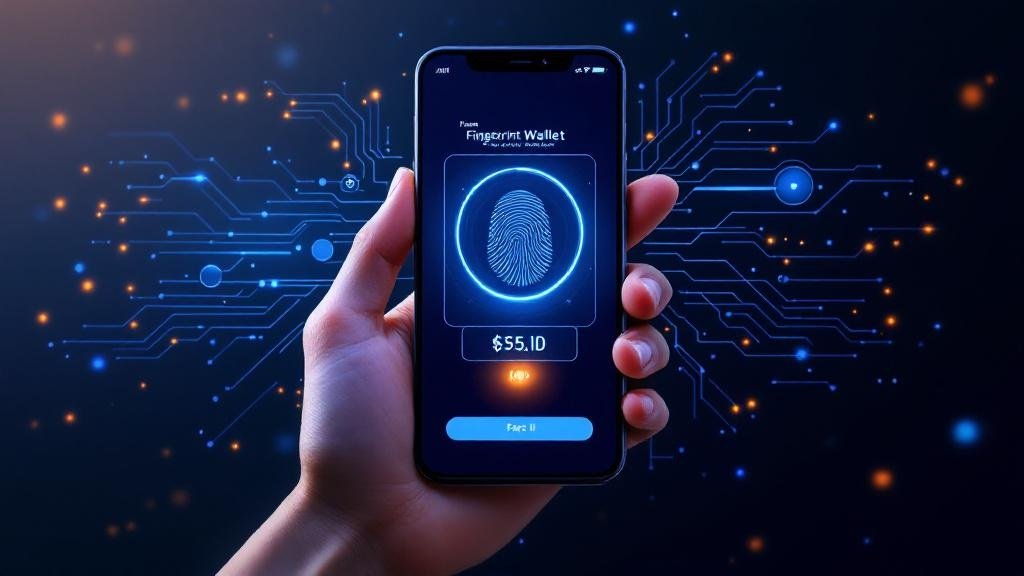In today’s fast-paced world, the way we manage payments is evolving rapidly, and digital wallets have become an integral part of our daily lives. But with convenience comes the pressing concern of security. As digital transactions grow, so does the need for advanced, secure authentication methods. Enter digital wallet biometrics — a revolutionary way to safeguard your payments. This post will delve into the world of biometric authentication in digital wallets, explaining everything from fingerprint authentication wallets to facial recognition payment systems. Whether you’re using a mobile wallet for shopping or storing sensitive payment info, biometrics are here to enhance both security and convenience.
What is Digital Wallet Biometrics?
Digital wallet biometrics refers to the use of biological identifiers, like fingerprints, face recognition, or voice patterns, to authenticate users in digital wallets. It replaces traditional PINs and passwords with something unique to you — your body. Biometric systems are integrated into digital wallets to provide a seamless, secure, and user-friendly way of authorizing payments and accessing stored information.
Key Types of Digital Wallet Biometrics:
Fingerprint Authentication Wallets
One of the most common forms of biometric authentication, fingerprint recognition uses the unique patterns on your fingertips to grant access to your digital wallet. This technology is already integrated into many smartphones, allowing users to authenticate payments quickly and securely.Facial Recognition Payment Systems
Facial recognition technology is becoming increasingly popular, especially with the rise of smartphones equipped with high-quality front-facing cameras. By scanning your face, these systems identify you in seconds, ensuring your digital wallet remains secure while making mobile payments.Voice Recognition
Some systems use voice recognition as an additional layer of security, allowing users to access their digital wallets by simply speaking a pre-set phrase. While not as widely used as fingerprint and facial recognition, this method is gaining traction.
Why is Biometric Authentication Important for Digital Wallets?
Digital wallets are designed for convenience, but they also hold sensitive financial data, which makes them prime targets for hackers. Biometric authentication adds a powerful layer of protection. Here’s why it’s crucial:
Unmatched Security: Biometric identifiers are difficult to replicate or steal, making them much safer than traditional passwords or PINs.
Convenience: Forgetting passwords is a thing of the past. With biometric login, accessing your wallet is a breeze.
Speed: Authentication happens in a matter of seconds, making payments and access to your wallet quick and smooth.
Digital Wallet Security Features with Biometrics
Using biometrics in digital wallets not only enhances security but also provides a better overall user experience. Here are some of the key digital wallet security features powered by biometrics:
Fingerprint Scanning Technology: This ensures that only your fingerprint can unlock your wallet, effectively reducing unauthorized access.
Facial Recognition: Advanced systems can even detect your face from different angles and lighting conditions, providing extra reliability.
Multi-Factor Authentication: For users who want extra security, combining biometrics with other methods like PIN codes creates a highly secure environment.
How Biometric Security for Mobile Payments Works
Biometric security works by capturing and analyzing certain unique biological features to confirm your identity. Here’s a basic breakdown of how it functions:
Capture: The biometric system scans your fingerprint, face, or voice to capture your unique features.
Encryption: Once captured, the biometric data is encrypted and stored securely, either locally on your device or in the cloud.
Verification: Every time you attempt to make a payment or access your wallet, the system compares your current biometric scan with the stored data.
Authentication: If the biometric data matches, the system authenticates the action, allowing you to proceed with the transaction.
How to Set Up Biometric Authentication for Your Digital Wallet
Setting up biometric authentication for your mobile payment app is usually a straightforward process. Here’s how you can do it:
1. Open Your Wallet App
Access the app on your smartphone or tablet, whether it’s Apple Pay, Google Pay, or any other digital wallet.
2. Navigate to Settings
Look for the “Security” or “Authentication” section of your app’s settings.
3. Enable Biometric Authentication
Choose between fingerprint recognition or facial recognition, depending on your device’s capabilities.
4. Scan Your Fingerprint or Face
Follow the on-screen instructions to register your fingerprint or face.
5. Test It
Once set up, try accessing your wallet or making a payment to test the biometric authentication.
Benefits of Using Biometric Authentication in Digital Wallets
Biometrics are rapidly becoming the preferred method of securing digital wallets. Here are some notable benefits:
Higher Accuracy: Biometric systems, especially fingerprint scanning technology, are highly accurate, making them harder to spoof.
Reduced Fraud Risk: By using your unique biological markers, the chances of fraud are significantly reduced. With digital wallet fraud prevention biometrics, your wallet is protected from unauthorized access.
Enhanced User Experience: With biometric authentication, you no longer need to remember complicated passwords, improving usability for users of all ages.
Digital Wallet Fraud Prevention and Biometrics
Fraud prevention is a key concern for any digital payment system. Biometric-based mobile wallet solutions add an extra layer of protection that traditional PINs or passwords simply can’t match. By verifying your identity through your unique biological traits, biometric identification for mobile apps significantly reduces the risk of fraud.
For instance, even if a hacker were to obtain your phone or access your account, they would still be unable to access your wallet without your fingerprint or face. This makes digital wallet biometrics a highly effective tool in fraud prevention.
Real-World Examples of Biometric Wallet Authentication
1. Apple Pay
Apple’s Face ID and Touch ID systems offer secure, fast, and reliable authentication for users looking to make payments via their digital wallet. Both facial recognition and fingerprint scanning have been integrated into Apple’s system, ensuring users have multiple options for secure access.
2. Google Pay
Google Pay also offers fingerprint authentication wallet options on Android devices. With a combination of multi-factor authentication digital wallets and biometric security, Google Pay ensures that payments are not only seamless but secure.
3. Samsung Pay
Samsung Pay uses both fingerprint scanning and iris scanning for added security, providing users with multiple biometric authentication methods to choose from.
FAQ: Digital Wallet Biometrics
1. What are the benefits of biometric authentication for digital wallets?
Biometric authentication offers better security, faster access, and more convenience than traditional PINs or passwords. It helps prevent unauthorized access to your digital wallet and makes transactions seamless.
2. Are biometric features in digital wallets secure?
Yes! Biometric data is unique to each individual and is often encrypted and stored securely. This makes it much harder for hackers to replicate or steal compared to traditional authentication methods.
3. Can I use facial recognition for payments on all digital wallets?
While many mobile payment apps with biometrics offer facial recognition, it depends on the wallet and the device’s capabilities. Popular apps like Apple Pay and Google Pay support facial recognition.
4. How does biometric data protection work in mobile wallets?
Biometric data is encrypted before being stored on the device, ensuring that your personal information remains safe. Additionally, biometric systems often use multi-factor authentication, adding another layer of protection.
5. What is multi-factor authentication in digital wallets?
Multi-factor authentication requires users to provide more than one form of verification, such as biometric data plus a PIN or password. This provides an extra layer of security.
6. Can I disable biometric authentication on my digital wallet?
Yes, most digital wallets allow you to disable biometric authentication in the settings and revert to traditional methods like PIN codes or passwords.
7. Are there any risks to using biometrics in mobile wallets?
While biometric authentication is generally secure, it’s important to stay vigilant. Always ensure your device is updated with the latest security patches to protect your digital identity management.
Conclusion
The integration of digital wallet biometrics like Face ID and fingerprint authentication wallets is reshaping the way we make payments. With heightened security, faster authentication, and a better overall experience, biometric systems offer clear advantages over traditional password-based methods. Whether you’re worried about digital payment security or simply want a more convenient way to authenticate payments, biometric-based mobile wallets are the way to go.
The future of mobile payments is here, and it’s more secure than ever. So, if you haven’t already, consider enabling biometric authentication for your digital wallet and enjoy the peace of mind that comes with it!








Comments (0)